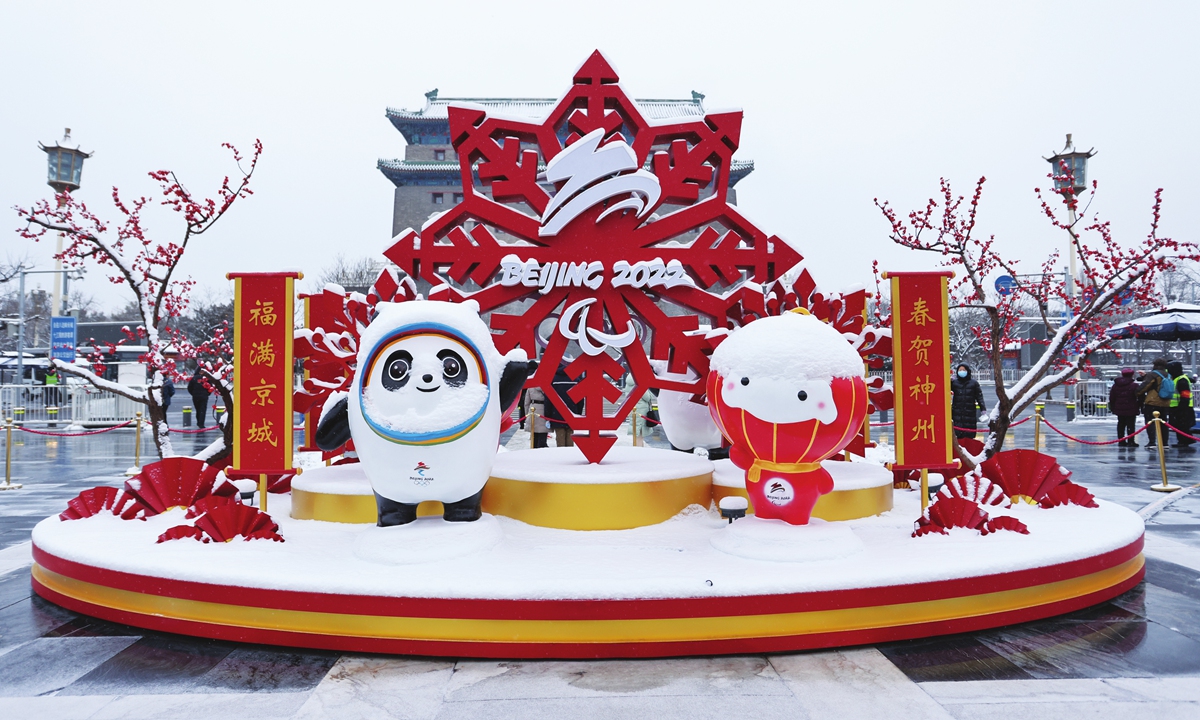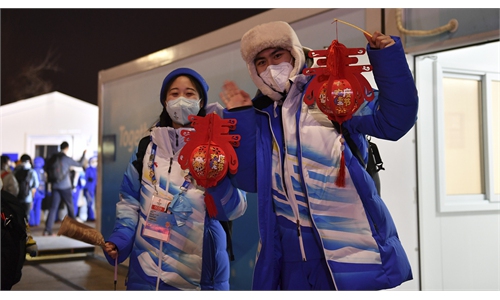
Sculptures of Bing Dwen Dwen (left) and Shuey Rhon Rhon on the street in Beijing Photo: VCG
Editor's Note:
Originating during Western Han Dynasty (206BC-AD25), the Lantern Festival, which was celebrated on Tuesday this year, marks the final day of Chinese Lunar New Year celebrations.
During the festival, people head out to see colorful lantern displays, solve riddles written on the lanterns and then go back home to have dinner and enjoy a special dessert. So what happens when this ancient festival meets one of the world's largest international sporting events? Let's take a look.
Adorable lantern mascot Shuey Rhon Rhon
The festival lantern is a traditional Chinese folk craft that dates back to the Han Dynasty (206BC-AD220). As the 2022 Lantern Festival was being celebrated during the ongoing Olympic Winter Games in Beijing, distinctive Olympic elements such as the mascots Bing Dwen Dwen and Shuey Rhon Rhon have made the festival super special in 2022.
Perhaps because Shuey Rhon Rhon is designed on the basis of a traditional lantern, this colorful Paralympic mascot has proven to be an extremely popular design for festival lanterns.
The anthropomorphic red Chinese lantern symbolizes a good harvest, courage and strength. Inspired by the lantern festival in her home town in Heilongjiang Province, Shuey's designer hoped to use the mascot to show the optimism and happiness celebrated during the Chinese festival and to pass on a positive message to athletes around the world.
"The development of Chinese folk arts is fluid and diverse. No matter if it is the dolls in Chinese Lunar New Year paintings or the adorable Shuey Rhon Rhon, they embody people's good wishes and love. Putting them on a lantern is Chinese people's artistic expression of our hopes. It is romantic," Qiu Er, a Chinese folk art expert, told the Global Times.
Winter Olympic riddles
The "Beijing 2022 lantern riddle challenge" on Sina Weibo has intrigued many netizens as it has creatively incorporated Olympic trivia in riddles such as "Gu Ailing landed first 1620, won the first gold medal for China in this event."
"My grandma is such a big fan of lantern riddles. Answering these riddles made her want to stay tuned to the Winter Olympics," a Sina Weibo user wrote.
Inspired by Beijing 2022, netizens have come up with their own Olympic lantern riddles to test their families or share online.
"Even though we don't plan to light a lantern this year, we are still going to ask riddles around the table after dinner. And we aren't just limited to the Lantern Festival today, I've come up with other Beijing 2022-related activities as well," Zhang Xuming, a 24-year-old illustrator in Chongqing, told the Global Times.
Lantern Festival dessert conquers hearts
"I know today is the Lantern Festival! I hope I can eat yuanxiao with black sesame filling," genius Chinese skier Gu Ailing said in an interview on Tuesday after winning a silver medal in the women's freeski slopestyle, her second Olympic medal.
Yuanxiao is a dessert consisting of balls of glutinous rice flour usually filled with sweet paste that is traditionally eaten during the Lantern Festival. The name is often used in northern China, while in southern China, the sweet dessert is often called tangyuan.
Gu also sent her best wishes to spectators amid the Lantern Festival, as did many other Chinese athletes such as fellow skier Xu Mengtao.
Xu, 31, won her first Olympic gold medal on Monday night in the women's aerials - freestyle skiing. After completing the event and learning her score, she shouted excitedly to the camera, "Happy Lantern Festival!"
Volunteers also made tangyuan at the Olympic Village to celebrate the festival on Monday, while many young Chinese people across the country gave play to their creativity to come up with interestingly shaped tangyuan of their own designs.
For many Chinese, tangyuan is typically eaten together with family. The round shape of the balls and the bowls in which they are served symbolize family cohesion.


